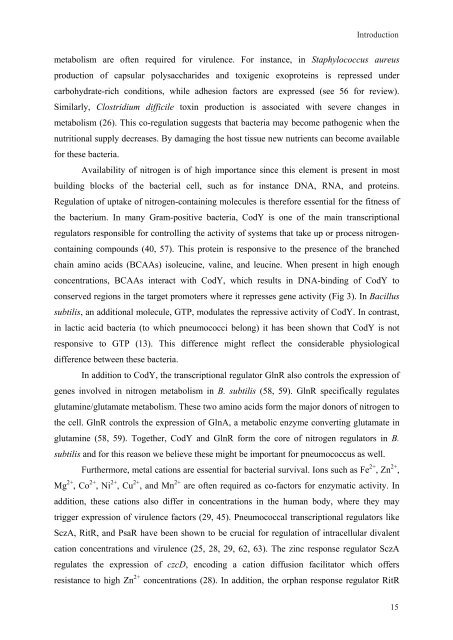Gene regulation in Streptococcus pneumoniae - RePub - Erasmus ...
Gene regulation in Streptococcus pneumoniae - RePub - Erasmus ...
Gene regulation in Streptococcus pneumoniae - RePub - Erasmus ...
Create successful ePaper yourself
Turn your PDF publications into a flip-book with our unique Google optimized e-Paper software.
metabolism are often required for virulence. For <strong>in</strong>stance, <strong>in</strong> Staphylococcus aureus<br />
production of capsular polysaccharides and toxigenic exoprote<strong>in</strong>s is repressed under<br />
carbohydrate-rich conditions, while adhesion factors are expressed (see 56 for review).<br />
Similarly, Clostridium difficile tox<strong>in</strong> production is associated with severe changes <strong>in</strong><br />
metabolism (26). This co-<strong>regulation</strong> suggests that bacteria may become pathogenic when the<br />
nutritional supply decreases. By damag<strong>in</strong>g the host tissue new nutrients can become available<br />
for these bacteria.<br />
Introduction<br />
Availability of nitrogen is of high importance s<strong>in</strong>ce this element is present <strong>in</strong> most<br />
build<strong>in</strong>g blocks of the bacterial cell, such as for <strong>in</strong>stance DNA, RNA, and prote<strong>in</strong>s.<br />
Regulation of uptake of nitrogen-conta<strong>in</strong><strong>in</strong>g molecules is therefore essential for the fitness of<br />
the bacterium. In many Gram-positive bacteria, CodY is one of the ma<strong>in</strong> transcriptional<br />
regulators responsible for controll<strong>in</strong>g the activity of systems that take up or process nitrogenconta<strong>in</strong><strong>in</strong>g<br />
compounds (40, 57). This prote<strong>in</strong> is responsive to the presence of the branched<br />
cha<strong>in</strong> am<strong>in</strong>o acids (BCAAs) isoleuc<strong>in</strong>e, val<strong>in</strong>e, and leuc<strong>in</strong>e. When present <strong>in</strong> high enough<br />
concentrations, BCAAs <strong>in</strong>teract with CodY, which results <strong>in</strong> DNA-b<strong>in</strong>d<strong>in</strong>g of CodY to<br />
conserved regions <strong>in</strong> the target promoters where it represses gene activity (Fig 3). In Bacillus<br />
subtilis, an additional molecule, GTP, modulates the repressive activity of CodY. In contrast,<br />
<strong>in</strong> lactic acid bacteria (to which pneumococci belong) it has been shown that CodY is not<br />
responsive to GTP (13). This difference might reflect the considerable physiological<br />
difference between these bacteria.<br />
In addition to CodY, the transcriptional regulator GlnR also controls the expression of<br />
genes <strong>in</strong>volved <strong>in</strong> nitrogen metabolism <strong>in</strong> B. subtilis (58, 59). GlnR specifically regulates<br />
glutam<strong>in</strong>e/glutamate metabolism. These two am<strong>in</strong>o acids form the major donors of nitrogen to<br />
the cell. GlnR controls the expression of GlnA, a metabolic enzyme convert<strong>in</strong>g glutamate <strong>in</strong><br />
glutam<strong>in</strong>e (58, 59). Together, CodY and GlnR form the core of nitrogen regulators <strong>in</strong> B.<br />
subtilis and for this reason we believe these might be important for pneumococcus as well.<br />
Furthermore, metal cations are essential for bacterial survival. Ions such as Fe 2+ , Zn 2+ ,<br />
Mg 2+ , Co 2+ , Ni 2+ , Cu 2+ , and Mn 2+ are often required as co-factors for enzymatic activity. In<br />
addition, these cations also differ <strong>in</strong> concentrations <strong>in</strong> the human body, where they may<br />
trigger expression of virulence factors (29, 45). Pneumococcal transcriptional regulators like<br />
SczA, RitR, and PsaR have been shown to be crucial for <strong>regulation</strong> of <strong>in</strong>tracellular divalent<br />
cation concentrations and virulence (25, 28, 29, 62, 63). The z<strong>in</strong>c response regulator SczA<br />
regulates the expression of czcD, encod<strong>in</strong>g a cation diffusion facilitator which offers<br />
resistance to high Zn 2+ concentrations (28). In addition, the orphan response regulator RitR<br />
15<br />
15

















